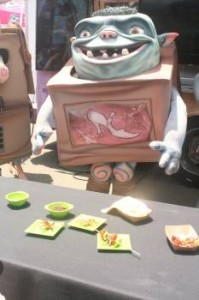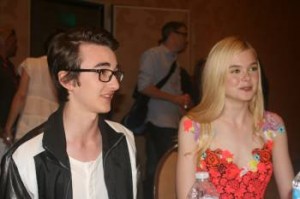Boxtrolls: Interviews at Comic-Con
Posted on September 24, 2014 at 8:00 am

In honor of the release of “The Boxtrolls” this week, I’m sharing some of the photos I took in July at Comic-Con, where I interviewed the cast and filmmakers and attended an “Eat Like a Boxtroll” lunch made up of insects. Star Isaac Hempstead Wright (of “Game of Thrones”) was clearly not excited about eating bugs, no matter how delectably prepared, but he was a very good sport.

I admit, I tried some grubs, but drew the line at anything crunchy or with legs.

Later, I sat with Sir Ben Kingsley, who plays the villain, to talk about performing all by himself, in a studio near his home in England. He described his character as “a social climber. He spends a lot of his energy trying to get into that club that doesn’t really want him to join. It’s a small, exclusive clique of guys who run the community. They’re quite reluctant to let him in. So he invents an enemy — politicians often do this — and says, ‘I’ll rid you of that enemy.'” He wants to power himself by destroying these very sweet, harmless creatures.” He was especially happy to work with LAIKA studios, producers of “Coraline” and “Paranorman,” because they are “quite fearless in family movies, putting light and shade together, bitter and sweet.”He modeled the voice and accent of his character on a man he knows who is anything but villainous, and said that to play a bad guy “I find the flaw, the one part in me that can’t be healed. I look for the crack and feel empathy for it. And love it….Storytelling is profoundly healing. And he told me the secret of his performance: he did all of the recording lying down. “Not a tense bone in my body, completely relaxed. If there’s tension in your neck and shoulders, it will show.”
Isaac Hempsted Wright and Elle Fanning play the film’s two main characters, Eggs, a boy raised by boxtrolls, and Winnie, the daughter of the town’s most important citizen, a wealthy and powerful man who is far more interested in tasting exotic cheeses than in noticing his daughter. Fanning, whose sister played the title role in LAIKA’s first film, “Coraline,” said that the script arrived with a box of drawings to give her a sense of what the setting and characters would look like, but she learned more every time she would record. She described Winnie as “spoiled, looking for someone to listen to her, but brave, and having to learn to grow up fast.” Hempsted Wright said Eggs is “plucky, feral, raised away from people and society, surrounded by class struggles and ‘cheese struggles.’ He has the best of both, the kindness of the boxtrolls and the bravery of humans.”
Fanning, whose sister played the title role in LAIKA’s first film, “Coraline,” said that the script arrived with a box of drawings to give her a sense of what the setting and characters would look like, but she learned more every time she would record. She described Winnie as “spoiled, looking for someone to listen to her, but brave, and having to learn to grow up fast.” Hempsted Wright said Eggs is “plucky, feral, raised away from people and society, surrounded by class struggles and ‘cheese struggles.’ He has the best of both, the kindness of the boxtrolls and the bravery of humans.”

